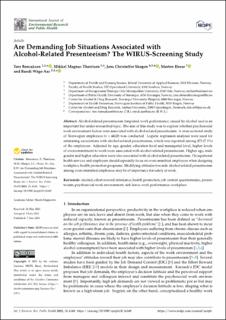| dc.contributor.author | Bonsaksen, Tore | |
| dc.contributor.author | Thørrisen, Mikkel Magnus | |
| dc.contributor.author | Skogen, Jens Christoffer | |
| dc.contributor.author | Hesse, Morten | |
| dc.contributor.author | Aas, Randi Wågø | |
| dc.date.accessioned | 2021-06-17T11:45:11Z | |
| dc.date.available | 2021-06-17T11:45:11Z | |
| dc.date.created | 2021-06-05T11:38:39Z | |
| dc.date.issued | 2021 | |
| dc.identifier.citation | International Journal of Environmental Research and Public Health (IJERPH). 2021, 18 (11), 6169-6169. | en_US |
| dc.identifier.issn | 1661-7827 | |
| dc.identifier.uri | https://hdl.handle.net/11250/2759968 | |
| dc.description.abstract | Abstract: Alcohol-related presenteeism (impaired work performance caused by alcohol use) is an important but under-researched topic. The aim of this study was to explore whether psychosocial work environment factors were associated with alcohol-related presenteeism. A cross sectional study of Norwegian employees (n = 6620) was conducted. Logistic regression analyses were used for estimating associations with alcohol-related presenteeism, which was reported among 473 (7.1%) of the employees. Adjusted by age, gender, education level and managerial level, higher levels of overcommitment to work were associated with alcohol-related presenteeism. Higher age, male gender and higher education were also associated with alcohol-related presenteeism. Occupational health services and employers should especially focus on overcommitted employees when designing workplace health promotion programs. Modifying attitudes towards alcohol-related presenteeism among overcommitted employees may be of importance for safety at work. | en_US |
| dc.language.iso | eng | en_US |
| dc.rights | Navngivelse 4.0 Internasjonal | * |
| dc.rights.uri | http://creativecommons.org/licenses/by/4.0/deed.no | * |
| dc.title | Are Demanding Job Situations Associated with Alcohol-Related Presenteeism? WIRUS-Screening Study | en_US |
| dc.type | Peer reviewed | en_US |
| dc.type | Journal article | en_US |
| dc.description.version | publishedVersion | en_US |
| dc.source.pagenumber | 6169-6169 | en_US |
| dc.source.volume | 18 | en_US |
| dc.source.journal | International Journal of Environmental Research and Public Health (IJERPH) | en_US |
| dc.source.issue | 11 | en_US |
| dc.identifier.doi | 10.3390/ijerph18116169 | |
| dc.identifier.cristin | 1913870 | |
| cristin.ispublished | true | |
| cristin.fulltext | original | |
| cristin.qualitycode | 1 | |

